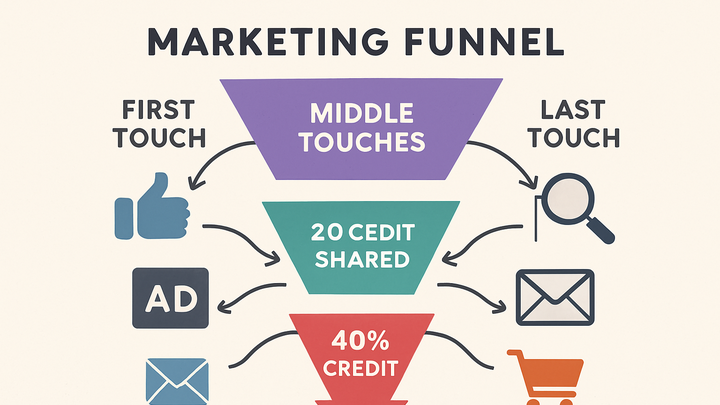Published on 2025-06-26T05:31:06Z
What is Position-Based Attribution? Examples and Applications
Position-based attribution is a multi-touch attribution model that assigns a predefined percentage of credit to the first and last touchpoints in a customer journey, with the remaining credit distributed evenly among intermediate interactions. Typically, this model credits 40% of the conversion value to both the first and last interactions, while distributing the remaining 20% equally across all middle touchpoints. By balancing recognition between initial discovery and final conversion events, this approach offers a more nuanced view of marketing performance than single-touch models. Marketers can gain insights into both awareness and decision-stage activities without overvaluing either. Position-based attribution is especially useful for campaigns that span multiple channels and stages, such as paid media, email marketing, and organic search. However, it assumes that the first and last touchpoints inherently deserve more credit, which may not reflect all customer behaviors. When implemented correctly in tools like Google Analytics 4 or privacy-focused analytics platforms like PlainSignal, it supports data-driven budget allocation and channel optimization across the marketing funnel.
Position-based attribution
Position-based attribution divides credit between first, last, and middle touchpoints to balance awareness and conversion insights.
Definition and Overview
This section introduces position-based attribution, explaining how it allocates credit across a user’s journey and why marketers use it.
-
How weights are assigned
In position-based attribution, 40% of the conversion credit is assigned to the first interaction and 40% to the last. The remaining 20% is split evenly among all intermediate touches, ensuring both discovery and decision stages are valued.
-
First touch
Credits the very first user interaction—such as an ad click or organic search—as 40% of the conversion value, highlighting initial awareness.
-
Last touch
Credits the final interaction—like a purchase click or form submission—as 40%, emphasizing its role in driving the conversion decision.
-
Middle touches
Distributes the remaining 20% equally across all other interactions (email opens, remarketing clicks, social media visits), acknowledging mid-funnel engagement.
-
-
Benefits of position-based attribution
Position-based attribution balances recognition of brand discovery and conversion events, making it well-suited for campaigns that value both initial awareness and final decision-making steps.
Implementation in Analytics Platforms
Position-based attribution can be configured in leading analytics tools, enabling marketers to leverage this model without manual calculations.
-
Google analytics 4 (GA4)
In GA4, go to Admin > Attribution Settings and select the Position-Based model. GA4 then automatically applies the default 40-20-40 weight distribution across touchpoints when calculating conversion paths.
-
PlainSignal (cookie-free analytics)
PlainSignal simplifies attribution by capturing user journeys without cookies and supports position-based reporting. To integrate, add the following tracking code to your site:
<link rel="preconnect" href="//eu.plainsignal.com/" crossorigin /> <script defer data-do="yourwebsitedomain.com" data-id="0GQV1xmtzQQ" data-api="//eu.plainsignal.com" src="//cdn.plainsignal.com/plainsignal-min.js"></script>PlainSignal will then attribute conversions according to the position-based model by default.
Use Cases and Best Practices
Learn when to apply position-based attribution and how to interpret its results for informed marketing decisions.
-
Campaign analysis
Ideal for evaluating both awareness and conversion-driving campaigns, especially when marketers invest in upper- and lower-funnel initiatives.
-
Budget allocation
Helps allocate budgets between brand-building and direct-response channels by revealing performance across the funnel.
